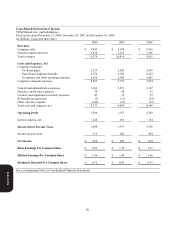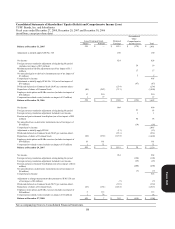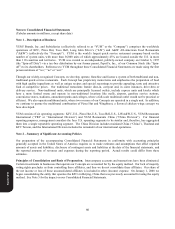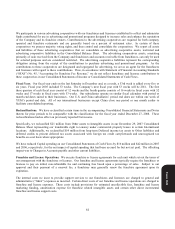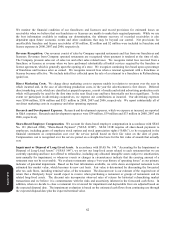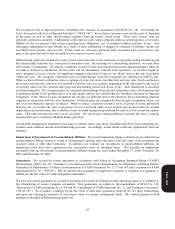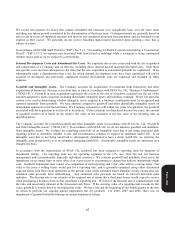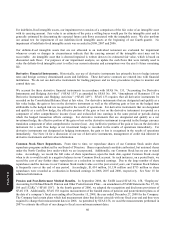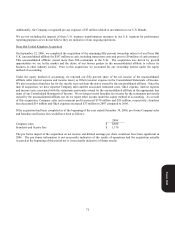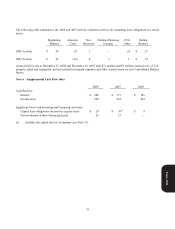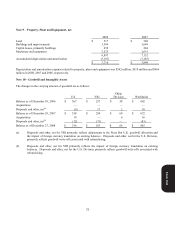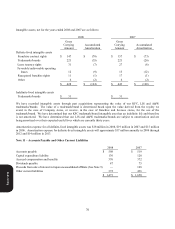Pizza Hut 2008 Annual Report Download - page 188
Download and view the complete annual report
Please find page 188 of the 2008 Pizza Hut annual report below. You can navigate through the pages in the report by either clicking on the pages listed below, or by using the keyword search tool below to find specific information within the annual report.
66
For indefinite-lived intangible assets, our impairment test consists of a comparison of the fair value of an intangible asset
with its carrying amount. Fair value is an estimate of the price a willing buyer would pay for the intangible asset and is
generally estimated by discounting the expected future cash flows associated with the intangible asset. We also perform
our annual test for impairment of our indefinite-lived intangible assets at the beginning of our fourth quarter. No
impairment of indefinite-lived intangible assets was recorded in 2008, 2007 and 2006.
Our definite-lived intangible assets that are not allocated to an individual restaurant are evaluated for impairment
whenever events or changes in circumstances indicate that the carrying amount of the intangible asset may not be
recoverable. An intangible asset that is deemed impaired is written down to its estimated fair value, which is based on
discounted cash flows. For purposes of our impairment analysis, we update the cash flows that were initially used to
value the definite-lived intangible asset to reflect our current estimates and assumptions over the asset’s future remaining
life.
Derivative Financial Instruments. Historically, our use of derivative instruments has primarily been to hedge interest
rates and foreign currency denominated assets and liabilities. These derivative contracts are entered into with financial
institutions. We do not use derivative instruments for trading purposes and we have procedures in place to monitor and
control their use.
We account for these derivative financial instruments in accordance with SFAS No. 133, “Accounting for Derivative
Instruments and Hedging Activities” (“SFAS 133”) as amended by SFAS No. 149, “Amendment of Statement 133 on
Derivative Instruments and Hedging Activities” (“SFAS 149”). SFAS 133 requires that all derivative instruments be
recorded on the Consolidated Balance Sheet at fair value. For derivative instruments that are designated and qualify as a
fair value hedge, the gain or loss on the derivative instrument as well as the offsetting gain or loss on the hedged item
attributable to the hedged risk are recognized in the results of operations. For derivative instruments that are designated
and qualify as a cash flow hedge, the effective portion of the gain or loss on the derivative instrument is reported as a
component of other comprehensive income (loss) and reclassified into earnings in the same period or periods during
which the hedged transaction affects earnings. For derivative instruments that are designated and qualify as a net
investment hedge, the effective portion of the gain or loss on the derivative instrument is reported in the foreign currency
translation component of other comprehensive income (loss). Any ineffective portion of the gain or loss on the derivative
instrument for a cash flow hedge or net investment hedge is recorded in the results of operations immediately. For
derivative instruments not designated as hedging instruments, the gain or loss is recognized in the results of operations
immediately. See Note 14 for a discussion of our use of derivative instruments, management of credit risk inherent in
derivative instruments and fair value information.
Common Stock Share Repurchases. From time to time, we repurchase shares of our Common Stock under share
repurchase programs authorized by our Board of Directors. Shares repurchased constitute authorized, but unissued shares
under the North Carolina laws under which we are incorporated. Additionally, our Common Stock has no par or stated
value. Accordingly, we record the full value of share repurchases, upon the trade date, against Common Stock except
when to do so would result in a negative balance in our Common Stock account. In such instances, on a period basis, we
record the cost of any further share repurchases as a reduction in retained earnings. Due to the large number of share
repurchases and the increase in our Common Stock market value over the past several years, our Common Stock balance
is frequently zero at the end of any period. Accordingly, $1,434 million, $1,154 million and $713 million in share
repurchases were recorded as a reduction in Retained earnings in 2008, 2007 and 2006, respectively. See Note 18 for
additional information.
Pension and Post-Retirement Medical Benefits. In September 2006, the FASB issued SFAS No. 158, “Employers’
Accounting for Defined Benefit Pension and Other Postretirement Plans – an amendment of FASB Statements No. 87, 88,
106 and 132(R),” (“SFAS 158”). In the fourth quarter of 2006, we adopted the recognition and disclosure provisions of
SFAS 158. Additionally, SFAS 158 requires measurement of the funded status of pension and postretirement plans as of
the date of a company’s fiscal year ending after December 15, 2008, the year ended December 27, 2008 for the Company.
The Company had certain plans which had measurement dates that did not coincide with our fiscal year end and thus were
required to change their measurement dates in 2008. As permitted by SFAS 158, we used the measurements performed in
2007 to estimate the effects of our change to fiscal year end measurement dates.
Form 10-K


